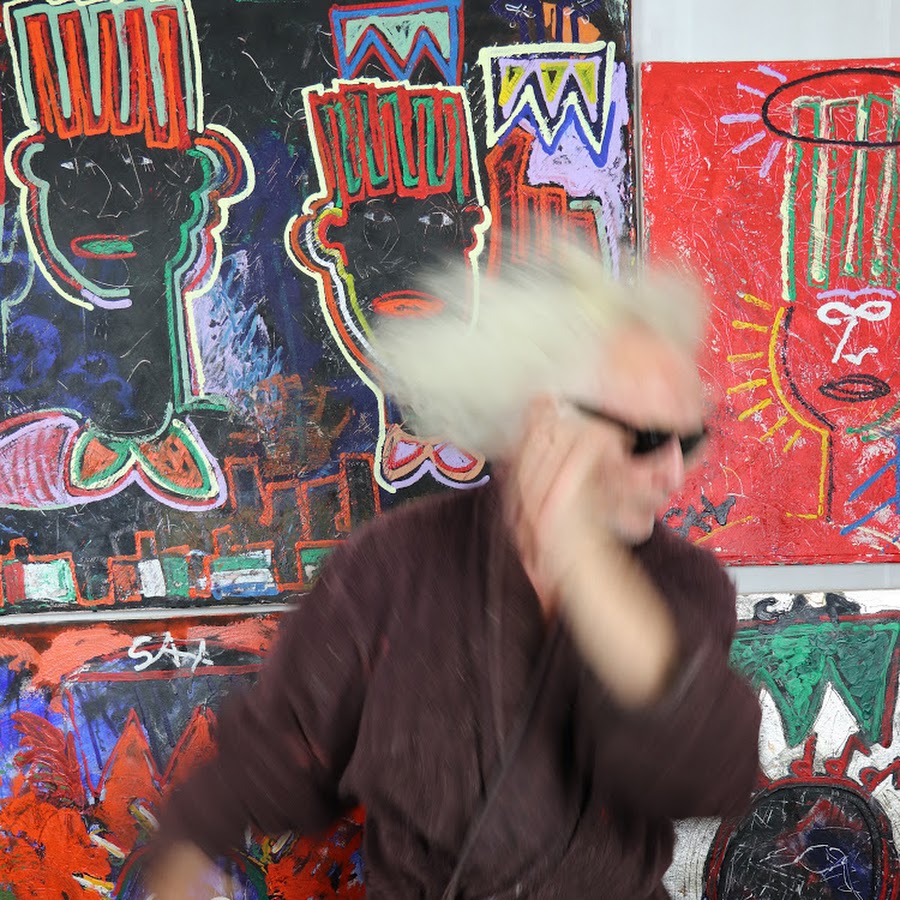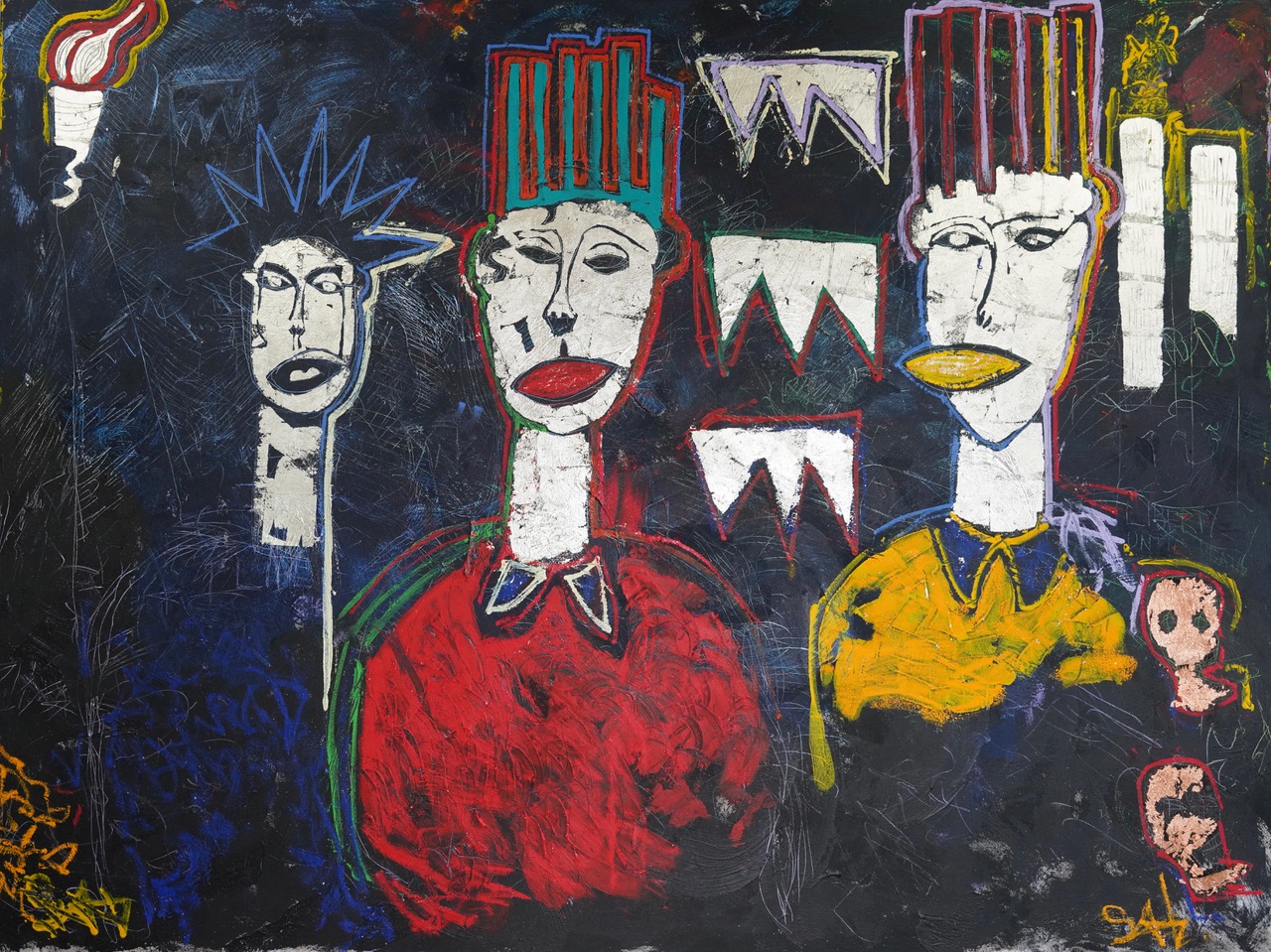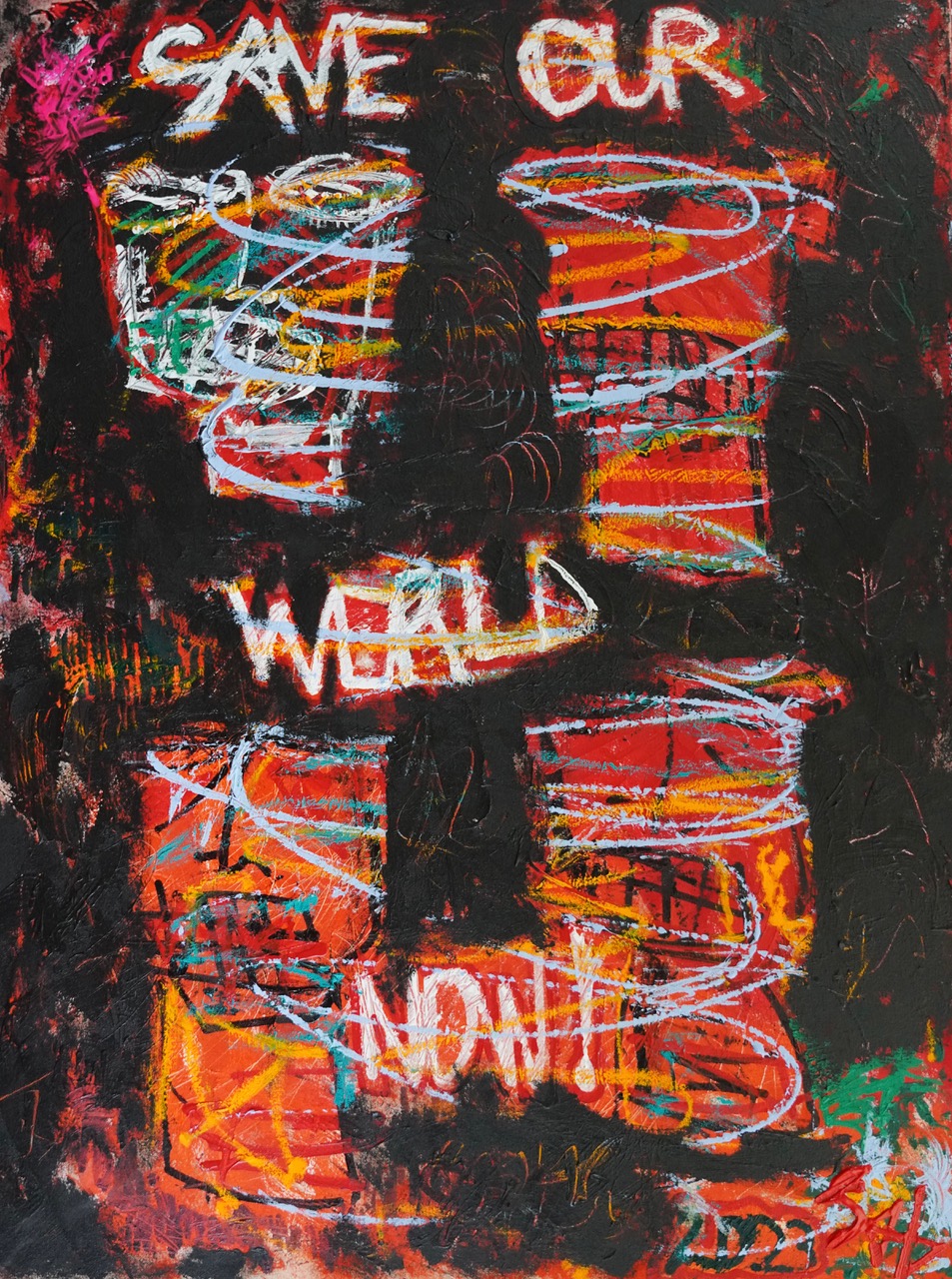
Step into a world where colors explode, emotions run wild, and art becomes an unapologetic rebellion against conformity. Welcome to the Renaissance of Neo Expressionism—a powerful movement that echoes the spirit of legends like Basquiat and Haring while paving its path towards the future. In this blog post, we dive deep into the captivating journey of English artist Sax Berlin and explore how he embodies the very essence of this artistic uprising. Get ready to be inspired as we unravel tales of creativity’s raw intensity intertwined with society’s stirring pulse—an exploration that will leave you craving more from this extraordinary wave sweeping across contemporary art.
A Brief History of Neo Expressionism: From Basquiat and Haring to Sax Berlin.
Neo Expressionism emerged in the late 1970s and early 1980s as a reaction against the minimalist and conceptual art movements that dominated the art world at the time. It aimed to revive traditional forms of expression, emphasizing emotion, personal experience, and individual creativity.
The movement was heavily influenced by German Expressionism from the early 20th century, which celebrated raw emotions and intense subjectivity in its rejection of academic traditions. However, Neo Expressionists gave this style a contemporary twist by incorporating elements of pop culture and street art.
Jean-Michel Basquiat and Keith Haring were two prominent figures in the Neo Expressionist movement based in New York City. Basquiat became known for his bold use of color, graffiti-style writing, and incorporation of cultural references such as African masks in his paintings. His works often tackled themes of race, identity, and power structures.
Similarly, Keith Haring gained popularity for his energetic line work and iconic symbolic images that reflected social issues such as AIDS awareness. Haring’s works were often displayed on public spaces such as subways and streets, blurring the boundaries between high art and street culture.
During this time period, there was also an emergence of another Neo Expressionist artist also living in New York who adopted similar styles. This is Sax Berlin from England whose works can be described as political commentaries with fast aggressive strokes challenging traditional norms.
Sax Berlin’s figurative works depict distorted faces with expressive features that convey a sense of turmoil and chaos, reflecting the state of society at the time. Like Basquiat and Haring, Sax Berlin also incorporated street art techniques.
Apart from New York, Neo Expressionism also saw a significant growth in Germany, especially in Berlin. The city’s vibrant underground culture and political landscape inspired artists such as Anselm Kiefer, Georg Baselitz, and Jörg Immendorff to create powerful and emotionally charged pieces that reflected their personal experiences living in post-World War II Germany. Their works often contained elements of shock, rebellion, and raw emotion.
The movement quickly gained international recognition through exhibitions such as the 1981 “A New Spirit in Painting” at the Royal Academy of Arts in London. However, by the late 1980s, Neo Expressionism began to decline as artists moved towards new forms of expression such as installation art and video art.
Despite its short-lived popularity, Neo Expressionism left a lasting impact on the art world. Its emphasis on individual expression and use of bold colors continue to influence contemporary art movements today. Artists like Jean-Michel Basquiat are still celebrated for their contributions to the movement whose influence can be seen in popular culture.
What is Neo Expressionism?
Neo Expressionism is an art movement that emerged in the late 1970s and early 1980s as a reaction against the minimalism and conceptual art of the preceding decades. It is characterized by its highly expressive and emotional style, often conveying raw human emotions through bold use of color, exaggerated gestures, and intense brushstrokes.
The term “Neo Expressionism” was first coined by German art historian Franz Roh in 1925 to describe the resurgence of expressionist tendencies in post-World War I Germany. However, it wasn’t until the 1970s that this term gained widespread recognition with the rise of artists such as Georg Baselitz, Anselm Kiefer, Jörg Immendorff, and A.R. Penck.
One of the key features of Neo Expressionism is its rejection of formal artistic elements such as composition and perspective, which were deemed too limiting and controlled. Instead, artists sought to convey their inner turmoil through unbridled self-expression on canvas or other mediums. These artists brought intense subjectivity to their work and with the rough handling of materials they raged in defiance of established movements in the mainstream art world.
In terms of subject matter, Neo Expressionists drew inspiration from everyday life experiences, ranging from personal struggles to socio-political commentary. Some critics have described Neo Expressionist works as chaotic or even grotesque due to their representation of fragmented figures or distorted forms.
However, one cannot deny the immense impact that Neo Expressionism had on contemporary art during its peak years in the 1980s. It challenged traditional notions of beauty and perfection while also bringing attention to marginalized voices in society
The Influence of Graffiti and Street Art on Neo Expressionism
The rise of Neo Expressionism as an art movement in the 1970s and 1980s was greatly influenced by graffiti and street art. These previously underground forms of expression quickly gained mainstream recognition, paving the way for a new wave of artists to emerge.
Graffiti, in its essence, is a form of self-expression that defies traditional artistic mediums. It often involves writing or drawing on public spaces without permission, challenging societal norms and making bold statements. This rebellious nature resonated with Neo Expressionist artists who sought to break away from academic conventions and create works that were raw, emotional, and reflective of contemporary culture.
The work of Jean-Michel Basquiat is a prime example of this influence. A former graffiti artist himself, Basquiat incorporated elements from street art such as bold lines, bright colors, and text into his paintings. His use of expressive brushstrokes and crude figures also reflected the spontaneity and energy associated with graffiti.
Another influential figure in the Neo Expressionist movement was Keith Haring. Haring’s iconic style drew inspiration from street art along with elements from pop culture and cartoon imagery. He used simple but powerful symbols to convey messages about social issues such as racism, AIDS awareness, and political power struggles. His murals on New York City subway walls became synonymous with street art and helped bring this form of expression into mainstream consciousness.
However, it wasn’t just American artists who were influenced by graffiti and street art when creating Neo Expressionist
The Characteristics of Neo Expressionist Art
Neo Expressionism emerged in the late 1970s as a response to the minimalist and conceptual art movements of the 1960s and 1970s. It was characterized by a return to emotional, expressive and figurative art forms, rejecting the cool intellectualism of its predecessors.
One of the defining characteristics of Neo Expressionist art is its rejection of formal artistic conventions. Artists sought to break away from traditional rules and techniques, instead embracing a raw and visceral style that relied heavily on instinct and emotion. This resulted in works that were bold, intense, and often chaotic.
Another key characteristic of Neo Expressionism is its use of bold colors and exaggerated forms. Artists employed strong brushstrokes, thick layers of paint, and distorted figures to convey feelings rather than realism. The use of vibrant colors was not only an expressionistic technique but also an intentional departure from the muted tones of previous movements such as minimalism.
The subject matter explored in Neo Expressionist art was deeply personal for many artists. It focused on themes such as sexuality, violence, identity politics, personal struggles, and societal issues. These themes were often depicted in metaphorical or symbolic ways rather than through direct representation.
Furthermore, there was a strong sense of urgency present in Neo Expressionist paintings. Many artists used their work as a form of protest against political oppression or social injustices during this time period. This sense of rebellion against authority can be seen in their expressive brushwork and confrontational imagery.
The Revival of Neo Expressionism: Why Now?
The revival of Neo Expressionism has been gaining momentum in the art world in recent years, with artists such as Basquiat and Haring leading the way. However, it is now experiencing a renaissance, with new artists like English artist Sax Berlin pushing the boundaries of this powerful art movement.
But why is Neo Expressionism making a comeback now? To answer that question, we must first understand what defines this artistic style. In its essence, Neo Expressionism is a reaction against minimalism and conceptual art, both of which dominated the art scene in the 1960s and 1970s. It is characterized by bold colors, intense brushstrokes, and emotional expression that seeks to convey raw emotion and energy.
In today’s fast-paced digital world where everything seems sterile and uniformed, there is a growing desire for authentic human expression. This craving for authenticity has fueled the revival of Neo Expressionism as more and more people seek out art forms that evoke strong emotions and capture their attention.
Moreover, with social media giving artists greater visibility on a global scale, there has been a shift towards personal storytelling through art. Artists are using their work to express their individuality and experiences rather than conforming to traditional standards set by society.
Sax Berlin embodies this shift towards personal expression within Neo Expressionism. He uses his own life experiences as inspiration for his vibrant paintings that reflect his inner turmoil and journey through addiction recovery.
Sax Berlin: An English Artist at the Forefront of the Movement
Sax Berlin is an English artist who has made a name for himself in the world of contemporary art. Born in the 1950s, Berlin matured during a time when Neo Expressionism was at its peak. Artists like Jean-Michel Basquiat and Keith Haring dominated the scene and Berlin is their contemporary, he painted on the same New York streets at the same time and it’s no surprise that he was heavily influenced by their styles and ideologies and he forged his own interpretations of the environment as he experienced it.
Berlin’s early work focused on themes of political decay and social commentary, somewhat mirroring the graffiti art of Basquiat and Haring. However over time his style has evolved and forged a more refined version of Neo Expressionism. Sax himself calls it his “Sharp Edge 21st Century Neo Expressionist New York City Style”
His bold use of vibrant colors, gold leaf and contrasting textures creates powerful visual impact in his artworks. These powerful, immediate paintings evoke strong emotions. The underlying theme in many of his pieces is the struggle between man and society, reflecting on issues such as consumerism, poverty, politics and human rights.
One noteworthy aspect of Berlin’s work is his constant experimentation with different mediums. He seamlessly combines traditional painting techniques with gold leaf and rapid movements, sometimes painting directly from the tube. His ability to constantly push boundaries has allowed him to establish an individualized voice within the Neo Expressionist movement.
Beyond his technical skills and artistic vision, Sax Berlin’s rise to prominence can also be attributed to his relentless commitment to social activism through art. He uses his platform as an artist to raise awareness about important global issues such as war, human rights violations and socio-economic disparities.
Examining Sax Berlin’s Work: Themes, Techniques, and Impact
Sax Berlin is an English artist who has gained recognition for his unique style and contributions to the Neo expressionist movement. His work combines bold, vibrant colors with abstract forms and emotive brushstrokes, creating powerful, provocative pieces that have captivated audiences worldwide.
In this section, we will examine Sax Berlin’s work in more detail, exploring recurring themes, techniques, and the impact of his paintings.
Themes:
One of the defining characteristics of Sax Berlin’s work is its deeply personal and introspective nature. He often draws inspiration from his own life experiences, using art as a medium for self-expression and reflection. This can be seen in his recurrent use of symbols and imagery such as masks, figures in motion, and fragmented faces.
Another prevalent theme in Sax Berlin’s artwork is the exploration of human emotions. His paintings are characterized by a raw intensity. Through his expressive use of color and brushwork, he captures the complexities of emotions such as love, fear, anger, and longing.
Sax Berlin’s work also addresses social issues such as inequality, violence,
and political turmoil. By incorporating these themes into his paintings, he aims to provoke thought and spark conversations about important societal problems.
Techniques:
Sax Berlin’s artistic technique is heavily influenced by the neo expressionist movement which emerged in Europe during the 1970s. Like other artists within this movement, he utilizes gestural brushstrokes with rough handling of materials to create dynamic compositions with a sense of energy and intense subjectivity.
Impact:
Berlin is uniquely placed to maximise the genre of Neo-Expressionism. He is an artist who has a shared experience of the original Neo-Expressionist painters and fortunately he has lived to continue and bring maturity and clarity to the movement. The immediacy of his canvasses impact new waves of art lovers and collectors as they decipher and disseminate his powerful messages.
For a short video of Sax Berlin in NYC click here.

The Future of Neo-Expressionism
The Future of Neo Expressionism is filled with potential for continuous growth and evolution. This art movement, which gained popularity in the 1970s and 1980s, is now experiencing a renaissance thanks to the works of contemporary artists such as Sax Berlin. The future looks bright for Neo Expressionism, as it continues to capture the attention of art enthusiasts around the world.
One of the most exciting aspects about the future of Neo Expressionism is its potential to attract a new generation of artists and viewers. As younger generations embrace this movement, we can expect to see even more daring and innovative expressions within the genre. The use of bold colors, abstract forms, and emotional depth are all elements that resonate with younger audiences who are looking for something fresh and unconventional.
In addition to technological advancements, we can also look forward to seeing how current global issues will shape the direction of Neo Expressionism in the future. Art has always been a reflection of society and a conduit for activism and as our world becomes increasingly complex and interconnected, we can expect artists within this movement to address these issues through their work. Whether it’s political turmoil or environmental concerns, Neo Expressionist art has the power to engender thought provoking conversations about topics that resonate with everyone.

